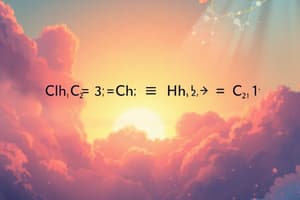Podcast
Questions and Answers
What transformation is represented by flipping a figure over a line?
What transformation is represented by flipping a figure over a line?
- Dilation
- Rotation
- Reflection (correct)
- Translation
Which type of transformation changes the orientation of a figure but preserves its size and shape?
Which type of transformation changes the orientation of a figure but preserves its size and shape?
- Translation
- Glide reflection
- Reflection (correct)
- Dilation
A figure is reflected over the y-axis. How does this transformation affect the coordinates of a point (x, y) on the figure?
A figure is reflected over the y-axis. How does this transformation affect the coordinates of a point (x, y) on the figure?
- (x, -y)
- (y, x)
- (-x, -y)
- (-x, y) (correct)
What is the line called that a figure is flipped over during a reflection?
What is the line called that a figure is flipped over during a reflection?
Which of the following properties is not preserved under reflection?
Which of the following properties is not preserved under reflection?
Consider a point A at coordinates (2, 3). After a reflection over the line y = x, what are the new coordinates of point A'?
Consider a point A at coordinates (2, 3). After a reflection over the line y = x, what are the new coordinates of point A'?
A triangle ABC is reflected, resulting in triangle A'B'C'. If angle ABC measures $60^\circ$, what is the measure of angle A'B'C'?
A triangle ABC is reflected, resulting in triangle A'B'C'. If angle ABC measures $60^\circ$, what is the measure of angle A'B'C'?
A line segment AB, 5 units long, is reflected over a line L. What is the length of the reflected line segment A'B'?
A line segment AB, 5 units long, is reflected over a line L. What is the length of the reflected line segment A'B'?
Rectangle ABCD is reflected over line m to create rectangle A'B'C'D'. If side AB is parallel to side CD, which statement is true about the reflected rectangle?
Rectangle ABCD is reflected over line m to create rectangle A'B'C'D'. If side AB is parallel to side CD, which statement is true about the reflected rectangle?
Triangle XYZ has vertices X(1, 1), Y(3, 1), and Z(2, 3). If the triangle is reflected over the line y = 0, what are the coordinates of point Z'?
Triangle XYZ has vertices X(1, 1), Y(3, 1), and Z(2, 3). If the triangle is reflected over the line y = 0, what are the coordinates of point Z'?
A square with vertices A(0, 0), B(1, 0), C(1, 1), and D(0, 1) is reflected over the line x = 0. What are the coordinates of vertex C' after the transformation?
A square with vertices A(0, 0), B(1, 0), C(1, 1), and D(0, 1) is reflected over the line x = 0. What are the coordinates of vertex C' after the transformation?
If a point P(5, -2) is reflected over the line y = x, what are the coordinates of its image P'?
If a point P(5, -2) is reflected over the line y = x, what are the coordinates of its image P'?
A figure is reflected sequentially over two parallel lines. What single transformation is equivalent to this double reflection?
A figure is reflected sequentially over two parallel lines. What single transformation is equivalent to this double reflection?
A figure is reflected sequentially over two intersecting lines. What single transformation is equivalent to this double reflection?
A figure is reflected sequentially over two intersecting lines. What single transformation is equivalent to this double reflection?
Circle A has a radius of 3 units. After reflecting Circle A over a line L, the new circle is Circle A'. What is the radius of Circle A'?
Circle A has a radius of 3 units. After reflecting Circle A over a line L, the new circle is Circle A'. What is the radius of Circle A'?
Consider a reflection over both the x-axis and then the y-axis. What single transformation is equivalent to these two successive reflections?
Consider a reflection over both the x-axis and then the y-axis. What single transformation is equivalent to these two successive reflections?
A regular pentagon is reflected over one of its lines of symmetry. How many lines of symmetry does the reflected pentagon have?
A regular pentagon is reflected over one of its lines of symmetry. How many lines of symmetry does the reflected pentagon have?
Line segment PQ has endpoints P(0, 4) and Q(3, 0). If PQ is reflected over the line y = -x, what are the coordinates of P'?
Line segment PQ has endpoints P(0, 4) and Q(3, 0). If PQ is reflected over the line y = -x, what are the coordinates of P'?
In the coordinate plane, performing a reflection over the line $y = x$, reflecting over the x-axis, and reflecting over the y-axis is equivalent to which single transformation?
In the coordinate plane, performing a reflection over the line $y = x$, reflecting over the x-axis, and reflecting over the y-axis is equivalent to which single transformation?
Flashcards
Reflection
Reflection
A transformation that flips a figure over a line, creating a mirror image.
Which image shows a reflection?
Which image shows a reflection?
Figure B
Study Notes
Chemical Reactions
- A chemical reaction converts one or more substances into different substances.
- A chemical equation uses chemical symbols to represent a chemical reaction.
- It shows the formulas of reactants (starting substances) and products (resulting substances).
- Reactants are on the left, products are on the right, separated by an arrow.
- $reactants \longrightarrow products$
- Balanced chemical equations have the same number of each type of atom on both sides.
Writing Balanced Chemical Equations
- Write the unbalanced equation using correct chemical formulas for reactants/products.
- Example: $CH_4(g) + O_2(g) \longrightarrow CO_2(g) + H_2O(g)$
- Find coefficients to equalize atoms of each element on both sides of the arrow.
- Balance elements that appear in only one reactant and one product, starting with elements other than H and O.
- Balance polyatomic ions as a unit.
- Balance H atoms, then O atoms.
- Example: $CH_4(g) + 2O_2(g) \longrightarrow CO_2(g) + 2H_2O(g)$
- Check that the number of atoms of each element is balanced.
- Ensure coefficients are the smallest possible whole numbers.
Additional Information in Chemical Equations
- States: $s$ (solid), $l$ (liquid), $g$ (gas), $aq$ (aqueous)
- $\triangle$ indicates addition of heat
- Chemical equations should specify the physical states of all reactants and products.
- Example: $CH_4(g) + 2O_2(g) \longrightarrow CO_2(g) + 2H_2O(g)$
Stoichiometry
- Is the quantitative study of reactants and products in a chemical reaction.
- Balanced chemical equations are used to determine the amounts of reactants and products.
Limiting Reactants
- The limiting reactant is completely used up in a reaction.
- The excess reactant is present in excess.
- The amount of product formed is determined by the limiting reactant.
- Example: $N_2(g) + 3H_2(g) \longrightarrow 2NH_3(g)$
- If 1 mol $N_2$ and 3 mol $H_2$ are present, both are completely used up
- If 1 mol $N_2$ and 2 mol $H_2$ are present, $H_2$ is limiting reactant
Reaction Yield
- Theoretical yield is the product amount if all limiting reactant reacts.
- Actual yield is the amount of product obtained from a reaction.
- Percent yield indicates the percentage of theoretical yield actually obtained.
- Percent yield = $\frac{Actual,yield}{Theoretical,yield} \times 100$%
Aqueous Solutions
- A solution is a homogeneous mixture of two or more substances.
- The solute is the substance present in a smaller amount.
- The solvent is the substance present in a larger amount.
- An aqueous solution has water as the solvent.
Electrolytes
- An electrolyte is a substance that, when dissolved in water, results in a solution that can conduct electricity.
- Example: $NaCl(s) \overset{H_2O}{\longrightarrow} Na^+(aq) + Cl^-(aq)$
- A nonelectrolyte results in a solution that does not conduct electricity.
- Example: $C_6H_{12}O_6(s) \overset{H_2O}{\longrightarrow} C_6H_{12}O_6(aq)$
Acids and Bases
- An acid produces $H^+$ ions when dissolved in water.
- Example: $HCl(g) \overset{H_2O}{\longrightarrow} H^+(aq) + Cl^-(aq)$
- A base produces $OH^-$ ions when dissolved in water.
- Example: $NaOH(s) \overset{H_2O}{\longrightarrow} Na^+(aq) + OH^-(aq)$
Types of Reactions
- Precipitation reaction, resulting in formation of an insoluble product
- Example: $AgNO_3(aq) + NaCl(aq) \longrightarrow AgCl(s) + NaNO_3(aq)$
- Acid-base neutralization reaction, involving reaction of an acid with a base
- Example: $HCl(aq) + NaOH(aq) \longrightarrow H_2O(l) + NaCl(aq)$
- Redox (oxidation-reduction) reaction, involving transfer of electrons
- Example: $2Mg(s) + O_2(g) \longrightarrow 2MgO(s)$
Concentration
- Is the amount of solute in a given quantity of solvent or solution.
Molarity (M)
- Expresses concentration as moles of solute per liter of solution.
- $M = \frac{moles,of,solute}{liters,of,solution}$
Dilution
- Is the process of preparing a less concentrated solution from a more concentrated one.
- $M_1V_1 = M_2V_2$
- $M_1$ and $V_1$ are molarity and volume of the concentrated solution.
- $M_2$ and $V_2$ are molarity and volume of the diluted solution.
- $M_1V_1 = M_2V_2$
Studying That Suits You
Use AI to generate personalized quizzes and flashcards to suit your learning preferences.



